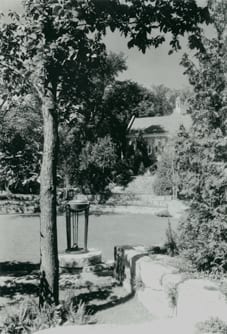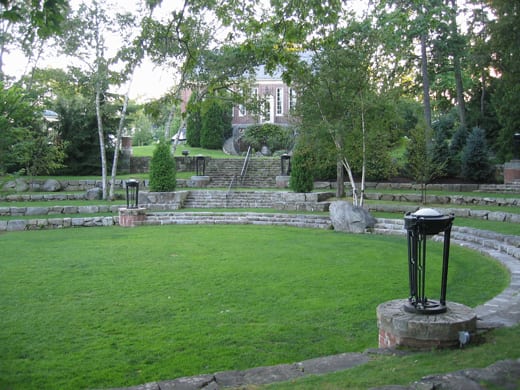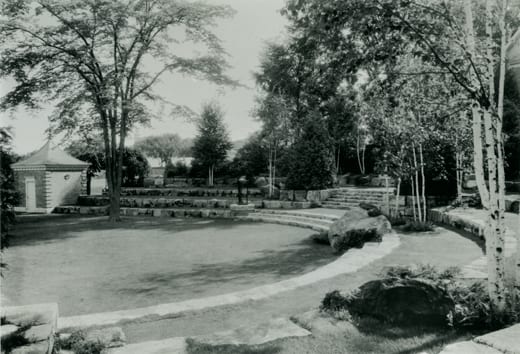Landmark Recognition of Steele’s Camden Amphitheatre: It Began with a Book / Camden, Maine (2013)
Camden, Maine

In early March, the U. S. Department of the Interior and National Park Service announced that the Camden (Maine) Amphitheatre and Public Library was among Thirteen newly designated National Historic Landmarks. The news that the amphitheater had received the nation’s highest level of historical recognition was especially gratifying to advocates because the determination was based on the property’s design by the landscape architect Fletcher Steele (1885–1971). “The Camden Amphitheater and Public Library is one of the few public projects of Fletcher Steele, one of America’s premier practitioners of twentieth-century landscape design,” the announcement explained. (The library building was designed by the architect Charles Loring.) “It is an outstanding representation of the contributions made by the landscape architecture profession, private benefactors, and national associations to develop public landscapes in the United States that celebrated natural regional beauty, scenic character, and rich cultural history.”
Steele died forty years after the Camden Amphitheatre’s completion in 1931, and within a decade his lifetime renown—and many of the nearly six hundred gardens he designed during his career—had all but perished too. This may not have surprised him. “Next to cooking,” he once observed, “gardening seems to be the most ephemeral of all the arts in America.” What is perhaps more unusual than Steele’s work passing into oblivion is its reemergence into public awareness. It began with a historian’s curiosity and doggedness. In 1985, when Robin Karson first proposed to write a book about Steele’s life and work, only a few American landscape architects—Charles Eliot, Frederick Law Olmsted Sr., and Jens Jensen—had been the subject of biographies. Publisher Ngaere Macray of Sagapress expressed enthusiasm for the idea, but Karson “met with blank stares and discouraging words on most other fronts,” she recalled later. She found exceptions among Steele’s clients and, particularly, his colleagues—Garrett Eckbo, Vincent Merrill, Peter Hornbeck, and Henry Hoover all voiced support for the project. Dan Kiley, who, like Steele, started out in the Massachusetts firm of Warren Manning, “was the most outspoken and clear in his assessment that Steele was ‘the only good designer working at the time,’” Karson wrote. Her book Fletcher Steele, Landscape Architect was published in 1989, followed by a revised edition in 2003.

“Karson’s comprehensive study of Steele’s work not only raised awareness for the importance of the amphitheater as a historic landscape, but set the garden within its context, proving its national significance as one of the nation’s finest examples of early American Modernism in landscape architecture,” says landscape historian Lucinda Brockway, who wrote the National Historic Landmark nomination.
On a sloping site of about an acre and a half, Steele created a horseshoe-shaped space with three terraces for seating, structured by granite retaining walls. Thickly planted aborvitae backed the apex of the enclosure, with clumps of white birch interspersed throughout. “Their white trunks stood in sharp contrast to the soft green of the turf and surrounding hemlock forest, providing vertical rhythm to offset the strong horizontal curves of the tiered stone ledges,” Karson observes. Though the planting design was modern in its abstraction and bentaxis orientation, the species were typical of local forests. Steele limited plants for the garden theater to those which grew within five miles of town. He interrupted the curving granite ledges with maple, birch, spruce, and enormous granite boulders. The overall effect is both rustic and elegant. Steele bolstered the elegance with tripod lights of his own design and a distinctive entrance on a small side street, consisting of stone steps flanked by brick ticket pavilions and Camperdown elms.

As idiosyncratic as these elements are, the most unexpected feature of Steele’s design is that instead of aligning the space on axis with the library building, he bent the axis, in the manner of the French modernists, pivoting the space about 45 degrees to take in the harbor view. Olmsted Jr., who was laying out a small park across Harbor Drive at the same time Steele was working on this plan, did not approve. But Steele’s patron, Mary Bok, supported his iconoclasm. Steele did not graciously suffer design by committee; his aversion to that process is why the Camden Amphitheatre is a rare example of his public work.
Both Steele’s amphitheater and Harbor Park were rehabilitated in 2004, according to a Historic Landscape Report and Preservation Treatment Plan commissioned from Heritage Landscapes. The two sites have matured admirably in the years since, the trees achieving a look of inevitability that Steele sought for his gardens. The stewardship evident in this very fine restoration no doubt played a role in the National Historic Landmark designation.
—Jane Roy Brown